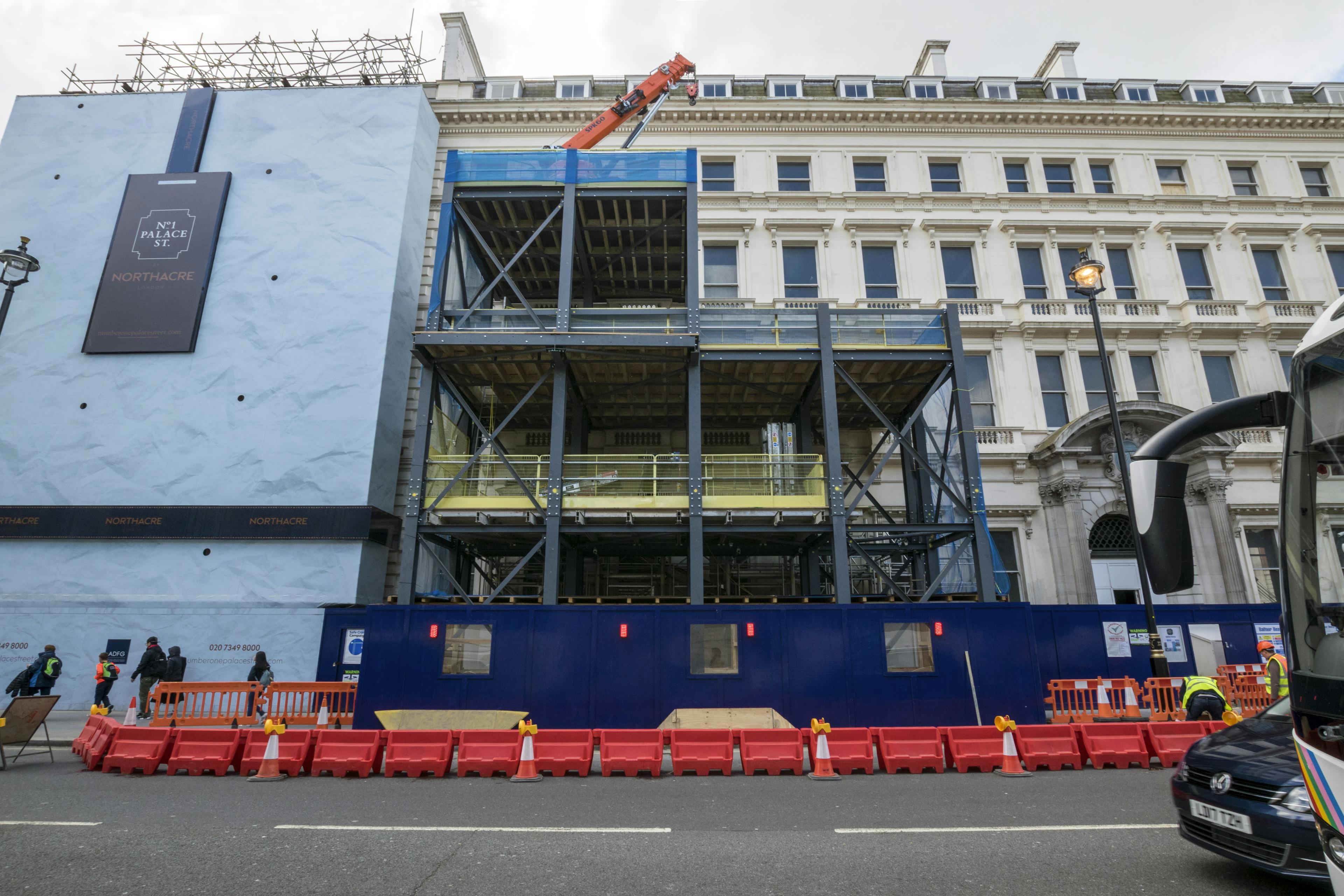
One Palace Street
Careys were contracted to undertake a prestigious cut and carve package including significant alterations, alongside groundworks, drainage and steel erection works on the building at this Grade II listed building, located opposite Buckingham Palace. The high-profile, central London site presented the team with a restricted working area and confined basement, requiring detailed planning and logistics management to deliver works.
Client
NorthacreLocation
LondonPrincipal Contractor
Balfour BeattyAn exceptional private residence located adjacent to the world-recognised location of Buckingham Palace. The redevelopment will include 72 ultra-luxury apartments, underground parking and communal gardens, as well as the restoration and remodelling of the various façades in Italian and French Renaissance, Beaux Arts and Queen Anne styles.
Enabling a safe and efficient logistics solution has been absolutely critical in enabling us to undertake works on the site. As One Palace Street is located immediately adjacent to Buckingham Palace, the City of Westminster council were concerned about the impact works would have on the busy pedestrian footpaths and traffic system directly outside the site.
To address these concerns, we developed a steel gantry solution which enables us to store materials outside of the building’s footprint, but over the walkway, in addition to creating a temporary loading bay for materials. In developing this walkway, we had to work around the presence of an active UKPN substation which powers Buckingham Palace, creating a load-spreading base for the footings within the narrow hoarding allowed by the council and preventing the gantry from damaging the paving or substation below. In addition to this, working closely with UKPN was crucial during these works to ensure our operations did not cause damage to the original 1890s structure when installing the 36 ton gantry above.
Bespoke waterproofing system specially fabricated to suit buildings layout
Bespoke waterproofing system specially fabricated to suit buildings layout
We completed a full and in-depth dilapidation survey for our client to ensure absolute clarity into the impact our proposed works would have on the valuable listed structure. This survey revealed significant structural dilapidation to the internal load-bearing floors of the building, requiring us to sequentially install transfer decks to bring new materials into the building and replace existing floors. This unique bracing system enabled us to remove existing floors whilst maintaining the stability of the façade and other structural elements.
Within the basement we installed a complex, bespoke waterproofing system using unique elements that had been specially fabricated to suit the building’s layout. The exacting installation process required to achieve the required grade of waterproofing led to us receiving specialist training by our supplier and enable the building to be rated as insurable.
Historic building’s loading transferred to new foundations
Historic building’s loading transferred to new foundations
As the original structure was nearly 200 years old, the weight-bearing capacity of the floors, walls and foundations were insufficient for modern properties. To overcome this, we transferred the building’s loading from the existing foundations to new foundations, installing needle beams through pad foundations and transfer beams on the new piles to enable us to jack the building and transfer the load. We carried out this transfer using hydraulic jacks and a monitoring system, carefully controlling the movement of the building and ensuring we prevented any damage to the listed building.
To overcome the space restrictions within the façade, we developed an ingenious system of lifts and conveyors to move materials around the building. This system travelled the height and length of the structure, entering and exiting at multiple points and requiring comprehensive testing to ensure that the gradient was set at the optimal level. We have successfully excavated in excess of 2,800m3 of material from the building, sending this up two floors and out onto the gantry to be off-loaded into muck-away lorries.
Furthermore, by deploying a small crusher within the basement, we have been able to crush all the concrete and bricks extracted and demolished during our works, reusing them in the pile mat and reducing the volume of material that needed to be extracted from the site.
Piling works within the basement comprised of 66x 450mm piles which were installed by Balfour Beatty with us being in attendance, managing and mobilising all required plant within the extremely confined basement, requiring exceptional delicacy to ensure that we did not damage listed assets which remained in place nearby.
Immaculate site set up and project management, metres away from world-recognised Buckingham Palace
Immaculate site set up and project management, metres away from world-recognised Buckingham Palace
Outstanding levels of project management have been crucial on the project to keep the programme on track, on budget and most importantly to keep all operatives safe. Working in such close proximity to the world-recognised tourist destination of Buckingham Palace has led to constant public scrutiny, requiring us to maintain a spotless site set-up and carefully managed operations to ensure pedestrians and traffic were not adversely affected by our works. Our exceptional standards of site management have ensured that works are undertaken without receiving any complaints from the Palace.
Transporting all materials into the site through the gantry initially seemed like the optimal solution, but due to the façade being maintained, we had to manually lift materials into and out of a small three by eight-foot window. This tiny opening meant that some items of heavy plant and machinery had to be deconstructed into their component parts to get them inside the façade and then reassembled within the building.
We'd love to hear from you, so please get in touch